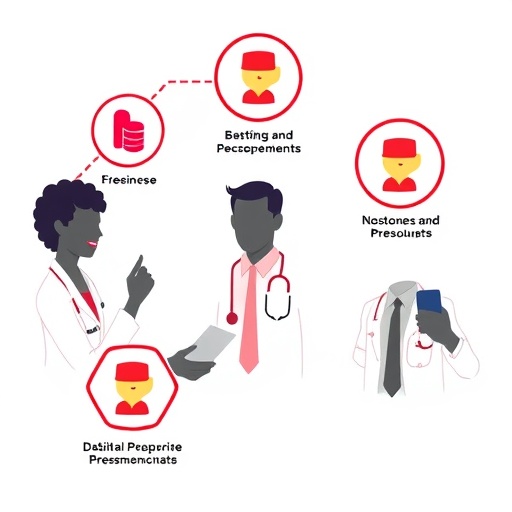Recent advancements in drug discovery are increasingly relying on sophisticated computational techniques, with deep learning emerging as a transformative approach. A groundbreaking study by Iqbal et al. illustrates the profound influence of deep learning in the identification of non-toxic human Hepatocyte Growth Factor Receptor (HGFR) inhibitors. This research not only emphasizes the potential of artificial intelligence in drug development but also lays the groundwork for creating safer therapeutic options for patients. Understanding the mechanisms that govern ligand-receptor interactions can significantly enhance the efficiency of discovering new pharmacological agents.
The human Hepatocyte Growth Factor Receptor, or HGFR, plays a pivotal role in various cellular processes, including proliferation, differentiation, and migration. Its aberrant activation is implicated in numerous disorders, particularly in cancer, where it contributes to tumor growth and metastasis. Thus, developing effective inhibitors that can specifically target and block HGFR activity is essential in the fight against these diseases, particularly when considering the critical need for safety in therapeutic applications. Traditional approaches have often faced challenges in predicting the toxicological profiles of these inhibitors, leading to a slower pace in drug development and an increased risk of adverse effects in patients.
In their study, Iqbal and colleagues harness a dual approach that integrates quantitative structure-activity relationship (QSAR) modeling with micro-scale molecular dynamics (MD) simulations. This method exploits the capabilities of deep learning algorithms to predict the biological activity of various chemical compounds based on their structural properties. By analyzing large datasets of known HGFR inhibitors and their corresponding biological activities, the researchers trained their deep learning models to identify patterns that indicate promising candidates for further development.
The QSAR models generated by Iqbal et al. showed remarkable accuracy in predicting the potency of new compounds against HGFR. Utilizing deep learning frameworks allowed the researchers to delve deeper into complex relationships that traditional QSAR methodologies might overlook. This ability to process and analyze vast datasets—often comprising thousands of compounds—enables the identification of novel potential inhibitors that are not just effective but also possess an acceptable safety profile.
On the molecular simulation front, micro-scale MD simulations provide a detailed view of the interactions at the atomic level between the proposed inhibitors and HGFR. Through this simulation technique, the researchers can visualize how the inhibitors bind to the receptor, assessing the stability of these interactions over time. This step is crucial in confirming the viability of the compounds identified as potential inhibitors through QSAR analysis. The combination of these computational techniques provides a robust framework for drug discovery, increasing the precision with which researchers can predict the efficacy and safety of new therapeutic agents.
The outcomes of this research not only highlight the effectiveness of deep learning algorithms but also propose a paradigm shift in how researchers can approach inhibitor discovery. By minimizing the reliance on traditional high-throughput screening methods—often costly and resource-intensive—the integration of machine learning approaches can streamline the process, making it more efficient and cost-effective. This paradigm shift has significant implications for pharmaceutical companies seeking to optimize their drug development pipelines, particularly in an era where budget constraints are a growing concern.
Moreover, the discovery of non-toxic HGFR inhibitors marks a significant advance in therapeutic strategies aimed at cancer treatment. The findings from Iqbal’s study could lead to the development of new drugs that not only target tumor growth but do so with reduced side effects. The emphasis on non-toxicity is particularly relevant in oncology, where current treatment options often carry severe toxicity profiles, which can diminish patient quality of life and adherence to treatment regimens.
As the demand for innovative treatments continues to rise, the strategy outlined in the study by Iqbal and colleagues stands out as a promising approach. With the combination of deep learning-driven QSAR analysis and micro-scale MD simulation, researchers can now better navigate the complexities of drug discovery. This methodology not only accelerates the identification of potent compounds but also enhances the understanding of the mechanisms at play in ligand-receptor binding.
The implications of this research extend beyond cancer therapeutics, as the techniques developed could be adapted to target various biological systems and diseases. The versatility of deep learning applications in pharmacology could eventually lead to breakthroughs in treating conditions ranging from neurodegenerative diseases to autoimmune disorders. This potential opens up new avenues for exploration, encouraging a more integrative approach to drug discovery that leverages technology’s capabilities.
As the integration of AI technology in pharmaceutical research continues to grow, the promise of safer and more effective drugs comes closer to realization. In the context of increasing global health challenges, the work of Iqbal et al. is a timely reminder of the importance of innovation in science and healthcare. By embracing new technologies and methodologies, researchers can bring forth a new generation of therapies that are not only effective but also prioritize patient safety.
The study serves as a pivotal reference for further investigations into HGFR inhibitors and paves the way for subsequent research endeavors that may utilize similar methodologies. As the scientific community continues to explore the depths of artificial intelligence in medicine, the findings articulated in this research will undoubtedly inspire related studies aimed at improving drug discovery processes across diverse therapeutic areas.
Ultimately, the findings of Iqbal and his team underscore a new era in drug discovery, where computational techniques, particularly deep learning, take center stage. These advancements are not only revolutionizing how we approach pharmacology but are also crucial for addressing pressing health challenges in today’s world. As we move forward, continuous collaboration between data science and traditional pharmacological research is essential to fully realize the potential of today’s innovative methodologies.
In conclusion, Iqbal et al.’s study not only highlights significant advancements in the identification of human HGFR inhibitors but also demonstrates the tremendous promise of deep learning and micro-scale simulations in the realm of drug discovery. This pioneering research could lead to breakthroughs that fundamentally change the landscape of therapeutic development, emphasizing the critical need for innovative approaches in addressing the complexities of human health and disease.
Subject of Research: Identification of non-toxic human Hepatocyte Growth Factor Receptor (HGFR) inhibitors using deep learning and molecular dynamics simulations.
Article Title: Deep learning-driven QSAR and micro-scale MD simulation-guided strategy reveals non-toxic human HGFR inhibitors.
Article References:
Iqbal, M.W., Raza, M.A., Sun, X. et al. Deep learning-driven QSAR and micro-scale MD simulation-guided strategy reveals non-toxic human HGFR inhibitors.
Mol Divers (2025). https://doi.org/10.1007/s11030-025-11380-7
Image Credits: AI Generated
DOI: 10.1007/s11030-025-11380-7
Keywords: Deep learning, QSAR, molecular dynamics, HGFR inhibitors, drug discovery.
Tags: advancements in therapeutic drug discoveryAI in drug discoverycancer treatment innovationscomputational techniques in medicinedeep learning in pharmacologyHepatocyte Growth Factor Receptor researchinhibitors for tumor growthligand-receptor interaction mechanismsnon-toxic therapeutic agentspredictive toxicology in drug designQSAR modeling for HGFR inhibitorssafety in drug development





